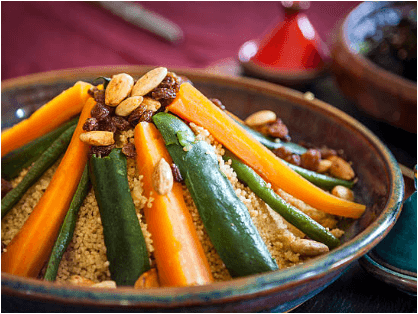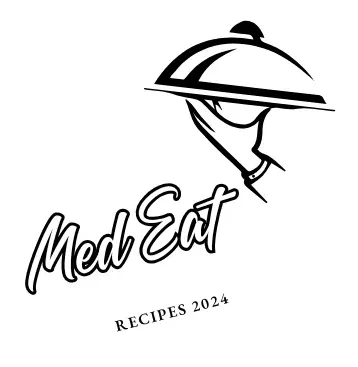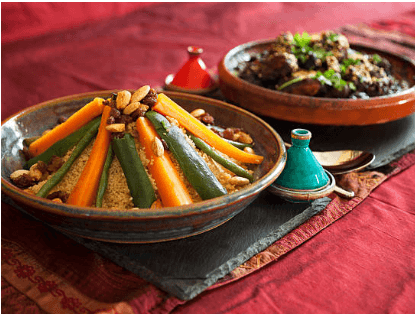Moroccan Couscous: The Ultimate Guide to a Classic Dish
As the sun sets over Marrakech, the smell of couscous fills the air. It invites you to try one of North Africa’s favorite dishes. Moroccan couscous is fluffy, with roasted veggies and spices. It’s a taste of the region’s rich culture.
This guide is for anyone who loves food. It will show you how to make perfect Moroccan couscous. You’ll learn about its history and the traditional ways of making it. It’s a journey into the heart of North African cuisine.
Table of Contents
Introduction to North African Culinary Heritage
Moroccan cuisine is known for its rich flavors, rooted in centuries-old traditions. At the heart of this is couscous, a dish that symbolizes Moroccan culture.
Origins of Couscous in Moroccan Culture
Couscous has been a staple in North Africa for over 2,000 years. Moroccan families would hand-roll the semolina, a process that showed their dedication to their culinary heritage.
Cultural Significance and Traditions
Couscous is deeply meaningful in Moroccan society. It’s served at special occasions and family gatherings. On Fridays, Moroccans come together to enjoy couscous, celebrating community and flavors.
Evolution of the Dish
While hand-rolling couscous is rare today, artisans still steam it to perfection. This method, using a couscoussière, creates a light and fluffy texture. It’s prized for soaking up the flavors of the stew or broth.
Moroccan cuisine’s fame has made couscous more popular worldwide. But for many, the traditional way of making it is key. It shows the lasting value of their culinary heritage.

“Couscous is not just a dish, it’s a way of life in Morocco. The time and care we put into its preparation reflects our deep respect for our culinary traditions.”
– Fatima, a Moroccan chef and culinary preservationist
What is Moroccan Couscous?
Moroccan couscous is a favorite in North Africa and around the world. It’s made from durum wheat semolina, which is crushed into a light, fluffy grain. This grain has a unique texture that makes it stand out from other semolina dishes.
When cooked, Moroccan couscous becomes delicate and airy. It’s perfect for holding onto a variety of flavors. Traditionally, it’s steamed to keep its shape and soak up the flavors of the stew or vegetables. Today, many people use boiling water to cook it faster.
| Metric | Value |
|---|---|
| Ratings received for classic Casablanca-style couscous recipe | 87 |
| Meat options suggested for the dish | 1 kilogram (about 2 1/4 pounds) bone-in lamb or beef, or 1 whole chicken |
| Vegetable oil used in the recipe | 1/4 cup |
| Vegetable oil required for preparing the couscous | 60 milliliters (about 1/4 cup) |
| Total water used in the cooking process | 2 1/2 liters (about 2 1/2 quarts) |
| Fresh parsley and cilantro sprigs for added flavor | 1 handful, tied into a bouquet |
| Dry chickpeas, soaked overnight (optional) | 1/4 cup |
| Dry couscous (not instant) needed for the dish | 1 kilogram (about 2 1/4 pounds) |
| Fresh fava beans (optional) | 1/2 cup |
Moroccan couscous is great with many ingredients. It can be used in side dishes, salads, and main courses. Its nutty flavor and fluffy texture make it a nutritious and versatile choice for both sweet and savory dishes.

Traditional Ingredients and Preparation Methods
Exploring traditional Moroccan recipes, couscous is a key part of Moroccan cuisine. Making authentic Moroccan couscous is a detailed three-step steaming process. It uses a special tool called a couscoussier.
Essential Spices and Aromatics
The heart of this dish is its aromatic spices. It includes semolina, olive oil, fresh vegetables, and spices like cumin, coriander, and cinnamon. These spices give it a warm, earthy smell and add to its rich flavor.
Authentic Cooking Techniques
Making Moroccan couscous is a labor of love. It needs patience and careful attention. The semolina is first dampened and rolled into small pearls. Then, it’s steamed three times to get the perfect fluffy texture.
Tools and Equipment Needed
- Couscoussier (a special steamer with a perforated upper pot)
- Large pot or saucepan
- Couscous grains or semolina
- Olive oil
- Assorted vegetables (such as carrots, zucchini, onions, and chickpeas)
- Spices (cumin, coriander, cinnamon, and more)
- Broth or stock
Learning to make traditional Moroccan couscous takes time and practice. But the effort is worth it. The mix of fragrant spices, tender vegetables, and couscous grains offers a unique and enjoyable dining experience.

Quick vs Traditional Steaming Methods
Preparing Moroccan couscous at home offers two options: quick or traditional. The quick way involves adding boiling water to spiced couscous and letting it sit for 15 minutes. This method is fast but might not give the fluffy texture of traditional steaming.
The traditional method takes more time but is worth it. It steams the couscous three times, each for 15 minutes. This approach makes the couscous fluffier and more authentic, a key part of Moroccan cuisine.
| Quick Method | Traditional Steaming |
|---|---|
| Add boiling water, cover, and let sit for 15 minutes | Steam the couscous three times, each for about 15 minutes |
| Faster preparation time | More time-consuming but yields a fluffier texture |
| Couscous may not be as fluffy | Results in a more authentic, traditional Moroccan couscous |
Choosing between quick and traditional methods depends on what you prefer. Both can make delicious Moroccan couscous. But, the traditional steaming is the true essence of traditional Moroccan recipes.
Essential Spices and Seasonings for Authentic Flavor
Moroccan cuisine is famous for its rich spices. These spices add depth and authenticity to dishes like couscous and tagines. The right mix of spices is key to capturing the essence of North African cooking.
Common Moroccan Spice Blends
Ras El Hanout is a key spice blend in Moroccan cooking. It can have up to a hundred spices. Common spices include cumin, coriander, paprika, turmeric, cinnamon, ginger, and saffron. This blend adds a unique flavor to many Moroccan dishes.
Balancing Flavors and Aromatics
- Cumin gives Moroccan dishes an earthy, smoky taste, perfect for tagines and soups.
- Coriander seeds add a citrusy flavor that balances the richness of Moroccan food.
- Paprika brings a sweet, smoky taste and a vibrant color to Moroccan dishes.
- Turmeric adds a golden color and a mild, earthy flavor to stews and rice.
- Cinnamon adds a sweet warmth, while ginger adds a spicy zest to marinades and spice mixes.
- Saffron is used sparingly for its unique flavor and golden color in special dishes.
Moroccan cooks balance these spices to create a symphony of flavors. This takes diners on a journey to North Africa’s vibrant markets and traditions.

Vegetable and Protein Combinations
Moroccan couscous is great for mixing different veggies and proteins. You can add colorful red bell peppers, soft carrots, zucchini, and onions. Chickpeas, a key ingredient in North Africa, add protein and are cooked with spices.
To add crunch and flavor, try sprinkling toasted almonds or pine nuts on top. Moroccan couscous is flexible, letting you choose veggies based on what you like or what’s in season. This makes it easy to make vegan couscous, vegetarian couscous, or couscous with vegetables to fit your diet and taste.
| Vegetable Additions | Protein Options |
|---|---|
|
|
Try out different veggie and protein mixes to make a Moroccan couscous that looks good and tastes great. There are so many options, letting you dive into the colorful world of this North African favorite.
Sweet and Savory Variations
Moroccan couscous is a dish that can be enjoyed in many ways. It often includes sweet elements like raisins, prunes, and sometimes apricots or dates. These dried fruits add a delightful contrast to the fluffy couscous grains, creating a harmonious blend of flavors.
For savory variations, the couscous can be served with roasted vegetables, spiced chickpeas, or grilled meats. It can be turned into couscous salads or hearty stews. This shows the depth and diversity of Moroccan cuisine.
Traditional Sweet Elements
The sweetness in Moroccan couscous comes from dried fruits like raisins, prunes, apricots, or dates. These ingredients add a touch of natural sweetness. They can be mixed into the couscous or served as a topping, letting you customize the flavor.
Savory Accompaniments
To balance the sweetness, Moroccan couscous can be paired with savory items. These include roasted vegetables like carrots, zucchini, or eggplant, as well as spiced chickpeas or grilled meats. The combination of fluffy couscous, tender vegetables, and flavorful proteins makes for a satisfying meal.
| Sweet Variations | Savory Variations |
|---|---|
|
|
Whether you like it sweet or savory, Moroccan couscous offers endless possibilities. Its adaptability lets you create a dish that suits your taste. This makes it a versatile and beloved staple in Moroccan cuisine.

Serving and Presentation Techniques
In Moroccan cuisine, how you present a dish matters a lot. Moroccan couscous is often served in a big dish. It’s topped with fresh herbs like parsley and cilantro, and pomegranate seeds for color and taste.
To make your Moroccan couscous look great, shape it into a mound on a platter. Make a well in the center for the meat or veggies. Arrange the veggies around the couscous mound, standing them up for a nice look. Then, drizzle the sauce over everything, making sure each bite is full of flavor.
By focusing on how your Moroccan couscous looks, you can make the meal even better. It’s not just about the taste; it’s about the experience. Whether it’s the main dish or a special presentation, your guests will love it.

